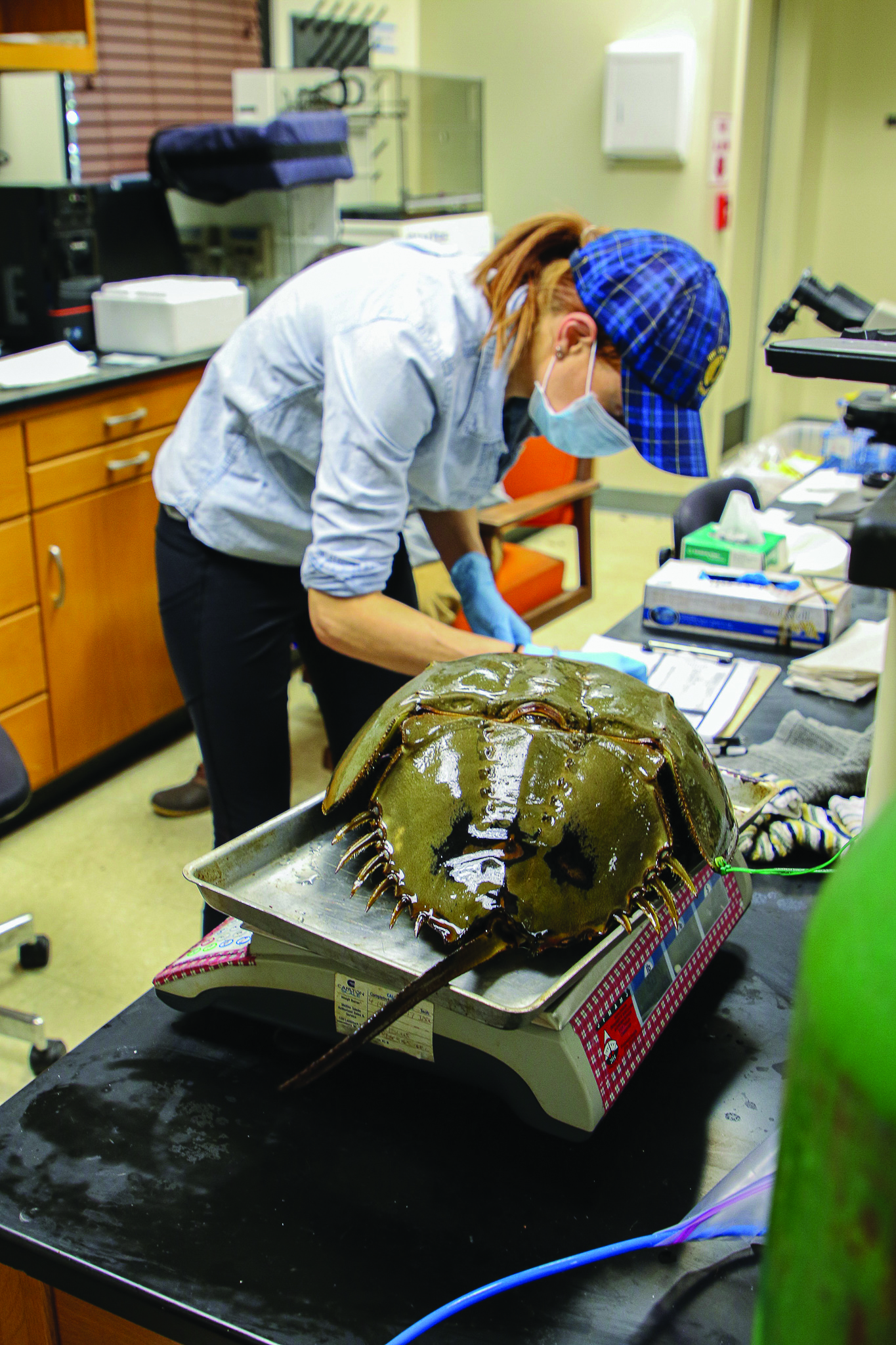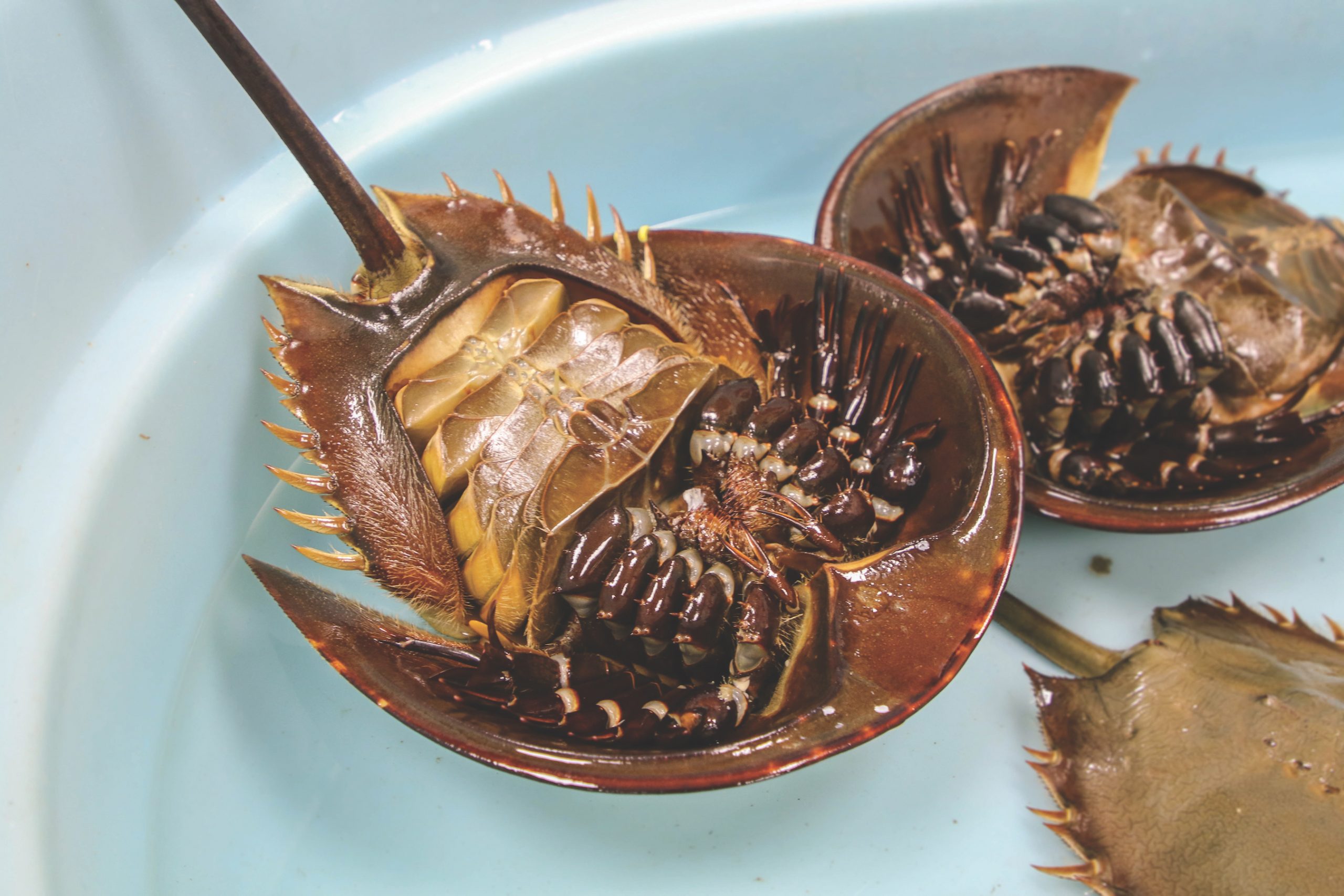
ILLUSTRATION BY ANDY LOWELL
Freaking out is understandable when encountering a horseshoe crab on the beach. After all, these ancient creatures have five pairs of legs, ten eyes, long spiky tails, and mouths on the bottom of their shells. They’re the incarnate version of those things inside the robot suits on Dr. Who, or a scale model of an extraterrestrial that Sigourney Weaver might battle. And if you come across a recently injured crab, you might discover another startling fact: It oozes azure blood.
The horseshoe crab might seem alien, but it probably shouldn’t. This animal has been here for somewhere around 450 million years, predating dinosaurs. “This is a very old species,” says Anthony Dellinger, president and lead scientist for North Carolina-based Kepley BioSystems, “with a very specialized immune system.” Paradoxically, that natural immunity contributes to the risk that the species now faces.
For the past few decades, the blue blood that protects horseshoe crabs from infection has become a key ingredient in a substance that ensures that biomedical devices, cosmetics, and certain drugs and vaccines are free from potentially deadly bacteria. The increased demand for crab blood for these medical purposes has led to dangerously aggressive harvesting. The resulting decline in the horseshoe crab population—the International Union for Conservation of Nature Red List classifies the crab as “vulnerable”—has had ripple effects through a coastal ecosystem stretching the entire Atlantic coast.
A small project on Jekyll has big ambitions: to reverse the fortunes of the horseshoe crab.
The Jekyll Experiment
Some 500,000 horseshoe crabs are captured every year for medical purposes, generally in May and June, when they flock to beaches to spawn. Captured crabs are bled and returned to the ocean, a process that can take up to 48 hours. How many survive the ritual is uncertain. Estimates put the mortality rate as high as 30 percent.
“Collection can be dangerous to the crabs and often is indiscriminate,” says Kristen Dellinger, a scientist at the University of North Carolina at Greensboro and a senior scientist at Kepley.

PHOTOGRAPH COURTESY OF MARINE EXTENSION AND GEORGIA SEA GRANT
Just as Western cattlemen protected the bison through controlled ranching, the Dellingers and Kepley hope their project on Jekyll Island, the first phase of what Kepley is calling the Horseshoe Crab Ranch & Blood Institute, can preserve the horseshoe crab.
Tucked into Tidelands Pond, adjacent to the 4-H Tidelands Nature Center on the southwest end of the island, the experiment is funded by a National Science Foundation grant and managed in partnership with the University of Georgia Marine Extension and Georgia Sea Grant. About 40 crabs are residents in the pond, all housed in 15-by-15 foot enclosures in a protected pool that is freshened daily by tidal flows.
Like those who herd livestock from pasture to pasture, the UGA marine extension team rotates the crab enclosures in the estuary to prevent “overgrazing,” says Bryan Fluech, associate director of extension at Marine Extension and Georgia Sea Grant. Aided by interns from the College of Coastal Georgia in Brunswick, Fluech’s team checks on the crabs, monitoring when and how often they feed, and supplements the natural food sources—such as krill and minnows—with other food. The crabs, it appears, are fond of anchovies.
Two of the crabs are test subjects for another innovation. They’ve been outfitted with ports—like those inserted for intravenous drips—which could allow labs to draw blood less invasively. “We’re wrestling with the economics and logistics,” says Kristen Dellinger. Kepley’s hope is that the next phase of the research, wherever that may be, will allow the company to explore the viability of commercialized ranching of crabs for medical research.
“The solution requires thoughtfulness to create a compassionate and humane solution,” says Anthony Dellinger.
An Ecosystem in the Balance
The contribution of horseshoe crabs to the biomedical industry is only a few decades old, but the crabs have played a pivotal role in sustaining an ecosystem stretching from South America to the Arctic for hundreds of thousands of years, says Abby Sterling. She’s a shorebird biologist with Manomet, a nonprofit that has spent decades on the conservation of shorebirds, including work with the Georgia Bight Shorebird Conservation Initiative.
Birds such as the Red Knot make stops on the North Atlantic coast en route from Southern Argentina to the Canadian Arctic. They feast on nutritiously dense and easily digestible horseshoe crab eggs, which can allow a single bird to double its weight. “Horseshoe crab spawning is an important resource for migration,” Sterling says. “The birds have to build up their weight to have fuel to get to the Arctic to build their nests and raise chicks.” The Delaware Bay has been the “epicenter” of this migratory pattern for millennia, but birds increasingly have been stopping further south, notes Sterling.

PHOTOGRAPH COURTESY OF MARINE EXTENSION AND GEORGIA SEA GRANT
Harvesting of horseshoe crabs by the fishing and biomedical industries now is regulated,
but the crab population still is dwindling, threatening the bird population. In the early 1990s, beaches in New Jersey held up to 100,000 eggs per square yard, a yield that has dropped to about 5,000, according to a 2018 report in Audubon magazine.
“Shorebirds face pressures including habitat loss, climate change, and Arctic warming,” Sterling says. “Losing an important nutrition source is another pressure.”
While crabs have been harvested for the biomedical industry in South Carolina, the industrial harvesting and bleeding of the crabs has been less prevalent here in the Southeast, which Sterling calls “one of the last strongholds” for the birds and crabs. “In Georgia, there has not been significant pressure on horseshoe crabs, and that’s something we want to maintain,” she says.
“The whole length of the hemisphere depends on these critical stopover places. Shorebirds need low-disturbance places to roost and to find food resources.”
The horseshoe crab project on Jekyll considers all these varying interests; public health, the health of shorebirds, the fishing industry, the survival of the crabs themselves, and the biomedical industry, says Anthony Dellinger. “When we approach a problem, we approach it in its entirety.”
From Here, A Global Reach
“We have been blown away by the reception in Georgia. Jekyll Island has been amazing to work with,” says Kristen Dellinger. In addition to collaborating with scientists at UGA and the host Jekyll Island Authority, a happy coincidence of the horseshoe crab project has been its proximity to the 4-H Tidelands facility, which has allowed researchers to connect with young people. “We are able to do outreach about this important species,” she says.
The Kepley researchers hope the project can be developed into a larger- scale model that will offer a more humane and sustainable way to harvest blood from crabs while also allowing wild populations to flourish without the impact of being bled. Beyond that, Sterling points to research into synthetic alternatives that could replace the need to draw blood from the crabs altogether. Eli Lilly, for example, has developed a compound that has been used in some testing and has been FDA approved for testing water sterility.

PHOTOGRAPH COURTESY OF MARINE EXTENSION AND GEORGIA SEA GRANT
“The harvesting of crabs for biomedical research is critical for human well-being, but it’s important to take into consideration the timeline of the relationship between birds and crabs that has developed over thousands of years,” says Sterling. “Reducing pressure on the horseshoe crabs would help birds, and it also would help the crabs.”
For Jekyll, the horseshoe crab experiment represents another step in the island’s wide-ranging conservation efforts. “In terms of this project, our goal is to step back and let the research unfold,” says Benjamin Carswell, Director of Conservation for the Jekyll Island Authority. The horseshoe crab project, with its potential to advance medical research, aid migratory birds, and to bolster the crab population up and down the coast, marks a reach beyond local conservation.
“This is exciting for us to host and be part of,” Carswell says. “Regionally and even globally, the impact of this project goes far beyond Jekyll.”






![The North Carolina Museum of Natural Sciences’ newest exhibit is a [pre]historic first](https://cdn2.atlantamagazine.com/wp-content/uploads/sites/4/2024/04/DD-3-100x70.jpg)



